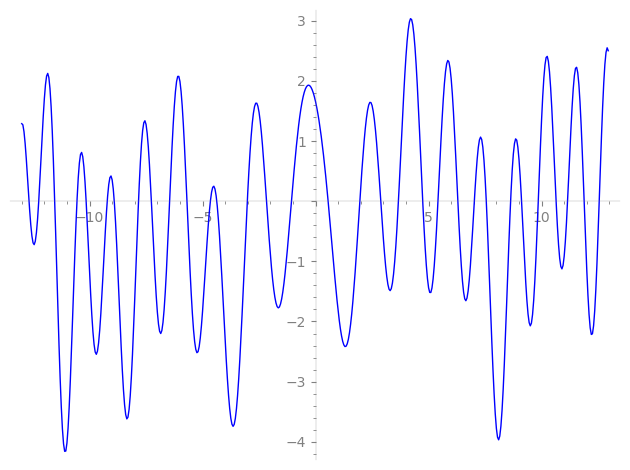| L(s) = 1 | + (0.5 − 0.866i)5-s + (1.5 + 2.59i)11-s − 4·13-s + (−2 + 3.46i)19-s + (4 − 6.92i)23-s + (2 + 3.46i)25-s + 3·29-s + (−2.5 − 4.33i)31-s + (−4 + 6.92i)37-s + 8·41-s + 6·43-s + (−5 + 8.66i)47-s + (4.5 + 7.79i)53-s + 3·55-s + (2.5 + 4.33i)59-s + ⋯ |
| L(s) = 1 | + (0.223 − 0.387i)5-s + (0.452 + 0.783i)11-s − 1.10·13-s + (−0.458 + 0.794i)19-s + (0.834 − 1.44i)23-s + (0.400 + 0.692i)25-s + 0.557·29-s + (−0.449 − 0.777i)31-s + (−0.657 + 1.13i)37-s + 1.24·41-s + 0.914·43-s + (−0.729 + 1.26i)47-s + (0.618 + 1.07i)53-s + 0.404·55-s + (0.325 + 0.563i)59-s + ⋯ |
Λ(s)=(=(3528s/2ΓC(s)L(s)(0.605−0.795i)Λ(2−s)
Λ(s)=(=(3528s/2ΓC(s+1/2)L(s)(0.605−0.795i)Λ(1−s)
| Degree: |
2 |
| Conductor: |
3528
= 23⋅32⋅72
|
| Sign: |
0.605−0.795i
|
| Analytic conductor: |
28.1712 |
| Root analytic conductor: |
5.30765 |
| Motivic weight: |
1 |
| Rational: |
no |
| Arithmetic: |
yes |
| Character: |
χ3528(3313,⋅)
|
| Primitive: |
yes
|
| Self-dual: |
no
|
| Analytic rank: |
0
|
| Selberg data: |
(2, 3528, ( :1/2), 0.605−0.795i)
|
Particular Values
| L(1) |
≈ |
1.655014260 |
| L(21) |
≈ |
1.655014260 |
| L(23) |
|
not available |
| L(1) |
|
not available |
L(s)=p∏Fp(p−s)−1 | p | Fp(T) |
|---|
| bad | 2 | 1 |
| 3 | 1 |
| 7 | 1 |
| good | 5 | 1+(−0.5+0.866i)T+(−2.5−4.33i)T2 |
| 11 | 1+(−1.5−2.59i)T+(−5.5+9.52i)T2 |
| 13 | 1+4T+13T2 |
| 17 | 1+(−8.5+14.7i)T2 |
| 19 | 1+(2−3.46i)T+(−9.5−16.4i)T2 |
| 23 | 1+(−4+6.92i)T+(−11.5−19.9i)T2 |
| 29 | 1−3T+29T2 |
| 31 | 1+(2.5+4.33i)T+(−15.5+26.8i)T2 |
| 37 | 1+(4−6.92i)T+(−18.5−32.0i)T2 |
| 41 | 1−8T+41T2 |
| 43 | 1−6T+43T2 |
| 47 | 1+(5−8.66i)T+(−23.5−40.7i)T2 |
| 53 | 1+(−4.5−7.79i)T+(−26.5+45.8i)T2 |
| 59 | 1+(−2.5−4.33i)T+(−29.5+51.0i)T2 |
| 61 | 1+(5−8.66i)T+(−30.5−52.8i)T2 |
| 67 | 1+(3+5.19i)T+(−33.5+58.0i)T2 |
| 71 | 1+10T+71T2 |
| 73 | 1+(−1−1.73i)T+(−36.5+63.2i)T2 |
| 79 | 1+(5.5−9.52i)T+(−39.5−68.4i)T2 |
| 83 | 1−7T+83T2 |
| 89 | 1+(−9+15.5i)T+(−44.5−77.0i)T2 |
| 97 | 1−17T+97T2 |
| show more | |
| show less | |
L(s)=p∏ j=1∏2(1−αj,pp−s)−1
Imaginary part of the first few zeros on the critical line
−8.906452039533697385749912433495, −7.83301046189338118479330706563, −7.26413396495480902480192714257, −6.45845115491488280649068569645, −5.68939193425972804540635666383, −4.65388339232225585497341646193, −4.37071512007147997793959811230, −3.01980056397732353003577921481, −2.17012861559638173780064386965, −1.06611658159492471904380735698,
0.55554333174917070613506621137, 1.95834232860131835420589245401, 2.88500172664999356380903062121, 3.66592370656790317181472622958, 4.74086892479543541939111575090, 5.41586058684899082141644201121, 6.29485844519005749814456139549, 7.02407493871765912489542844214, 7.55292415496206884369343412541, 8.629227630009887279145540022626

